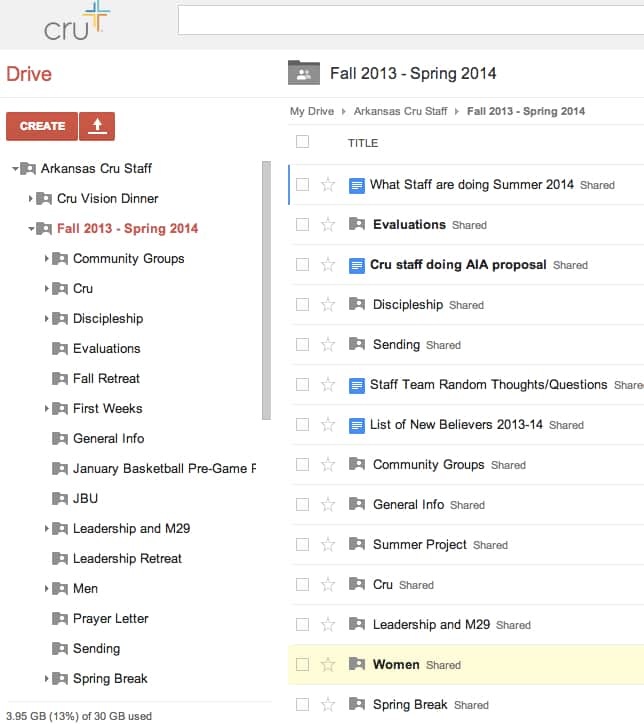The absolute best thing our Staff did this past year was implement a once a month checkpoint with our Community Group leaders (we got the idea from University of Florida Cru).
Here’s why it was so helpful – our monthly CG coaching meeting kept our most important leaders motivated and missional all year long. As I said in a previous post, Community Groups are the backbone of our ministry. So if our CG leaders are dying on the vine, the fruit of changed lives will not happen.
Many (most!?) times in our monthly checkpoints, we’d meet with CG leaders who were about to throw in the towel. They had zero people coming. And they were tired of pursuing flaky freshmen. Or they had 2-3 freshmen coming to studies and had given up hope of getting a more robust study. Our staff meeting with them help them recalibrat their dreams to keep pursuing freshmen so that freshmen could experience a more healthy community of 6-8 peers.
In 2013 we lost 30% of our Community Group leaders over the course of the year. This year we only lost 5% on the women’s side and 17% on the men’s side.
In 2013 we lost 55% of our freshmen from December to May (260 freshmen in CG’s in December 2012 – by May 2013 we had 117). In 2014, we only lost 1% of our freshmen (160 freshmen in December to 158 in May). Obviously the Monthly Coaching Appointment wasn’t the only factor in retaining freshmen in Community Groups. But it definitely helped that 1/3 of our leaders didn’t quit (like the previous year).
Here’s how we set up the appointment with CG leaders:
- We are committed to helping you succeed as a Community Group leader. I want to meet with you and your co-leader to help you think through where your study is headed and work alongside you to help your study thrive!
The general flow of a monthly CG coaching meeting:
- Time in the Word
- Who/Where/When
- Who
- Write down who’s coming to their group and talk through next steps for them:
- Verbally process through — where are each of them are at spiritually —
- “Are there any guys/girls in this group who you don’t know where they’re at spiritually?”
- “who from this group have you already met with?”
- “who is on the fringes/not connecting?”
- Prioritize meeting with those guys/girls and sharing the gospel with them
- Who do you want to start pursuing as a possible disciple (make sure you communicate: “don’t commit yet!”)
- Verbally process through — where are each of them are at spiritually —
- Write down who’s coming to their group and talk through next steps for them:
- Where are you meeting (give them suggestions – meet on campus! meet in a key person’s room)?
- When are y’all meeting? Is that time working well?
- Who
- How are you doing in each of the 4 areas?
- Content (if upperclassmen – what content are you doing?)
- How is it going in cultivate self-discovered learning (discussion oriented vs lecture)?
- Do not preach at them –make sure that as a leader, you are not doing the majority of the talking!
- Mission (how can we help you grow your study?)
- Get on Mission Hub during your appointment and show them how to look up guys/girls in their dorm checked — “I want to be in a Bible study”
- Encourage them to call these people
- Right before your study: MAKE PHONE CALLS/TEXT AND KNOCK ON DOORS (College students are FLAKY.)
- Keep an updated contact list and include everyone on a group reminder text the morning you meet. You want to do this every week the rest of the semester.
- Take solid freshmen girls to do follow up with you
- Encourage your freshmen to invite their friends to CG
- Get on Mission Hub during your appointment and show them how to look up guys/girls in their dorm checked — “I want to be in a Bible study”
- Prayer
- Ideas: pray for the world, prayer walk, pray through scripture, prayer requests, prayer partners, fasting
- Community – do you feel like people are starting to connect?
- Content (if upperclassmen – what content are you doing?)
- What are next steps in each of these 4 areas?
- Plan the next month
- Print up and bring blank semester at a glance planning chart and help them map out the next month
- End on vision
- Encourage them — what you’re doing is significant!
- It’s a slow process of investing on a weekly basis in these guys/girls. The little things will begin to pay off (the texts, little conversations, times to hang out). God is using you to change their lives!!
- If there’s no one coming to their study – there’s 300 girls in the Quads who need to know Christ! Keep going for it. It’s worth it!!
We ended up meeting twice a semester with our CG leaders.
Here’s notes from each from each meeting:







